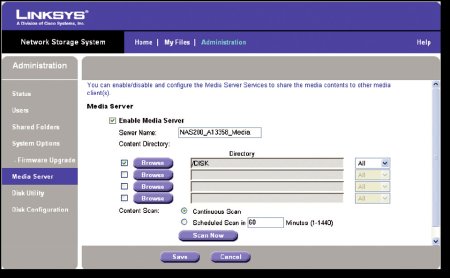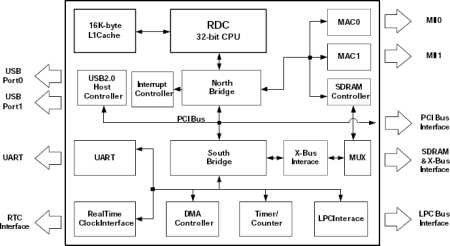Linux-based SLUG spawns highly hackable NAS
Sep 6, 2007 — by LinuxDevices Staff — from the LinuxDevices Archive — 86 views Cisco's consumer products division is shipping a successor to the Linux-based NSLU2 (aka “SLUG”) consumer NAS (network-attached storage) appliance, one of the most-hacked devices ever. The NAS200 has room for two internal SATA drives, supports FAT32-formatted external USB 2.0 drives, and comes with UPnP media-sharing… software.
Cisco's consumer products division is shipping a successor to the Linux-based NSLU2 (aka “SLUG”) consumer NAS (network-attached storage) appliance, one of the most-hacked devices ever. The NAS200 has room for two internal SATA drives, supports FAT32-formatted external USB 2.0 drives, and comes with UPnP media-sharing… software.
(Click for larger view of NAS200)
digg this story |
As delivered out of the box, the NAS200 appears to be a very simple consumer device aimed at Windows PC users, or at least users with SMB-based networks. However, a nicely organized source code tree and a system-on-chip processor executing applications built for the 486 architecture could ultimately make the NAS200 even more popular with hackers than the NSLU2, for which multiple alternative firmware builds have cropped up.
The NAS200's stock firmware supports only Windows networking. Missing are the more esoteric file-sharing protocols of more expensive home NAS servers — ftps, https, rsync, nfs, scp, and so on — as are more expensive hardware features, such as gigabit Ethernet and WiFi.
On the upside, there is a web interface, which appears configurable to offer both open and password-protected shares. And, a download manager allows users to paste in an ftp or http file resource locater, to download, for example, movies directly to the storage device.

NAS200's download manager
(Click to enlarge)
Another nice feature is a built-in UPnP server. If executed correctly, this feature should enable any computer on the same subnet to access music, photos, and videos stored on the NAS200.

The NAS200's UPnP config screen
(Click to enlarge)
Users can purchase the NAS200 standalone, for use with USB hard drives (FAT32 appears to be the sole supported filesystem). They can later add one or two internal drives. Simple-Simon web-based configuration screens provide the option to configure both internal drives as a single logical unit, and to add redundancy and/or striping.
Users can also connect and optionally format USB drives with up to four partitions; a pair of high-speed (480Mbps) USB 2.0 host ports are included on the rear panel. Scheduled backups also appear to be supported, possibly in conjunction with Windows-based client utilities.
What's under the hood?
LinkSys offers a massive 240+ MB download of GPL-licensed code for the NAS200. To date, however, the NAS200 does not appear to have attracted any community developers interested in replacing Samba with NFS, adding rsync, or other improvements.
In fairness, the NAS200 appears to be fairly new to the market; in time, the NAS200 could well outshine the famous NSLU2, a device so popular with hackers that it is supported by Debian's newest installers, and is largely credited with making ARM the third-most popular Debian architecture.
LinkSys's software download for the NAS200 includes source code for both Linux 2.6.19 and eCos 2.0. This is probably because the device uses the redboot bootloader, which is built as an application on top of eCos.
LinkSys was kind enough to include a .config file in the 2.6.19 source code tree, as well as makefiles for building both Linux and redboot. The Linux tree appears to be configured for a 486-class processor with ACPI and Transmeta's LongRun power-saving technology.
Reports on the web suggest that the processor delivers 44 “Bogomips,” and to be an RDC R3210-G (PDF datasheet download). This RISC-based SoC executes a 486 instruction set, similar to the RDC SoCs that have powered tiny Linux-based wireless access points from half a dozen companies.

RDC's R3210 architecture diagram
(Click to enlarge)
The .config file also includes serial interface support, suggesting the NAS200's board may have pin headers or solder points for a serial console interface. A post at NSLU2-linux.org suggests the console port to be located at JP1.
The NAS200 appears to have 8MB of flash storage memory. Of that, a Linux filesystem appears to account for 5.2MB. Mounting the filesystem's ROM image (supplied by Linksys in the source-code download) using Linux's loopback device suggests that the NAS200 includes busybox, tinylogin, an ash shell, date and hwclock (the device supports NTP updates), and ftp. Other open source applications present include libupnp, cron, hdparm, lvm, smtpclient, sfdisk, mdadm, mksquashfs, devmapper, inetd, samba-3.0.22 (pre-GPLv3), smartmontools, thhtpd, udhcp, xfsprogs, and wget.
Availability
The NAS200 appears to be widely available, priced at about $130 without drives.
This article was originally published on LinuxDevices.com and has been donated to the open source community by QuinStreet Inc. Please visit LinuxToday.com for up-to-date news and articles about Linux and open source.